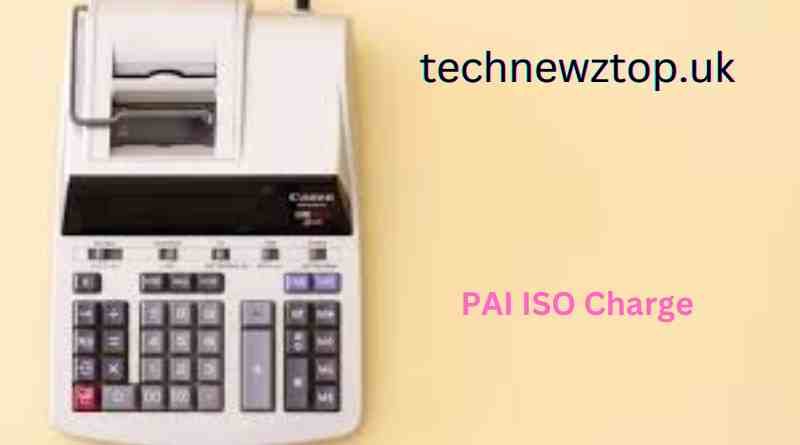Understanding the PAI ISO Charge on Your Bank Statement

In today’s complex financial ecosystem, various charges and terms appear on our bank statements that often leave us puzzled. One such term that has garnered attention is the “PAI ISO” charge. This article delves into the intricacies of the PAI ISO charge, providing a comprehensive understanding that demystifies its presence on your bank statement.
What is PAI ISO?
PAI ISO stands for Payment Alliance International Independent Sales Organization. PAI, a prominent entity in the financial services sector, provides ATM services and payment processing solutions for businesses. An Independent Sales Organization (ISO) is a third-party payment processing company that is authorized to handle merchant accounts. They are the intermediaries between merchants and the bank’s credit card networks, facilitating the processing of card payments.
The Role of PAI ISO in Payment Processing
PAI ISO plays a pivotal role in the payment processing ecosystem. They offer a range of services including but not limited to merchant account setup, payment gateway solutions, ATM installations, and maintenance services. Their involvement ensures that businesses, irrespective of their size, can securely and efficiently process payments, thereby enhancing customer experience and facilitating smoother transactions.
Understanding Charges Associated with PAI ISO
When a business decides to utilize the services of PAI ISO, several charges may be incurred. These charges are typically reflected in the business owner’s bank statement and can vary depending on the services availed. Some common fees include transaction fees, monthly account maintenance fees, ATM service charges, and equipment rental fees. It is crucial for business owners to thoroughly review their contracts and statements to understand these charges.
Why You See PAI ISO Charges on Your Bank Statement
If you are a consumer, spotting a PAI ISO charge on your bank statement might be confusing. Generally, consumers do not directly deal with PAI ISO. However, if you use your credit or debit card at a business that processes payments through PAI ISO, you might see a reference to this on your statement. This is typically not a direct charge to you but an indication of where the transaction was processed.
Decoding the Charges: What to Look For
Business owners, on the other hand, should scrutinize their bank statements for PAI ISO charges to ensure they are accurate and justified. Look for detailed descriptions of each charge, the date, and the amount. If there are discrepancies or unexpected fees, it’s essential to contact PAI ISO or your bank immediately.
How to Manage and Negotiate PAI ISO Charges
- Understand Your Contract: Before entering into an agreement with PAI ISO, thoroughly review the terms and conditions. Pay close attention to the fee structure, including any hidden fees.
- Negotiate Terms: Depending on your business volume and relationship, you may have leverage to negotiate better rates or lower fees.
- Regular Review: Regularly review your bank statements and compare them with your PAI ISO agreement to ensure all charges are as agreed upon.
- Customer Support: Utilize PAI ISO’s customer support for any clarifications or disputes regarding charges.
The Impact of PAI ISO Charges on Businesses
While the services provided by PAI ISO are essential for modern businesses, the associated costs can impact your bottom line. It’s vital for business owners to consider these charges as part of their overall operating expenses. Effective management and negotiation of these fees can lead to significant savings, thereby improving profitability.
PAI ISO and Industry Compliance
PAI ISO adheres to stringent industry standards and compliance regulations, ensuring secure and efficient payment processing. For businesses, partnering with a compliant ISO like PAI can mitigate risks associated with data breaches and fraud.
The Future of Payment Processing with PAI ISO
The payment processing industry is continuously evolving, with advances in technology and changes in consumer behavior driving innovation. PAI ISO is at the forefront of these changes, offering cutting-edge solutions that cater to the dynamic needs of businesses. From mobile payment options to enhanced security features, PAI ISO is poised to support businesses in navigating the future of transactions.
Conclusion
The presence of a PAI ISO charge on your bank statement is a sign of the complex nature of modern financial transactions. For business owners, understanding these charges is crucial for effective financial management. By staying informed and proactive in managing these expenses, businesses can ensure they are getting the best value from their payment processing services.
This exploration of PAI ISO charges highlights the importance of transparency and knowledge in the financial services sector. Whether you are a consumer curious about a charge on your statement or a business owner calculating your operating costs, the key is to stay informed and engaged with your financial transactions. In doing so, you can navigate the intricacies of payment processing with confidence, ensuring that your financial dealings are both secure and efficient.







